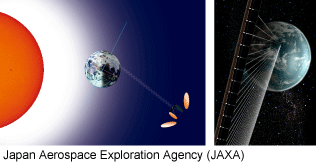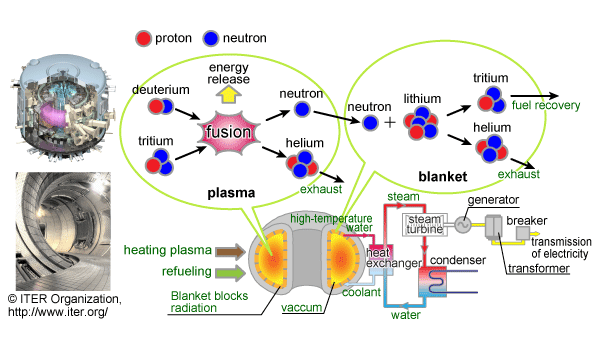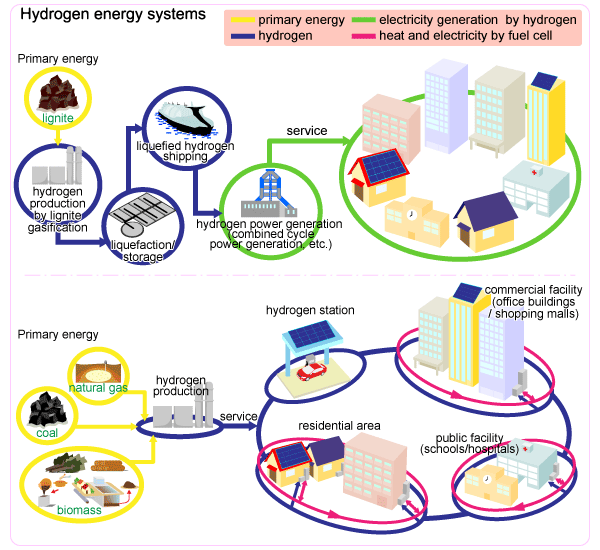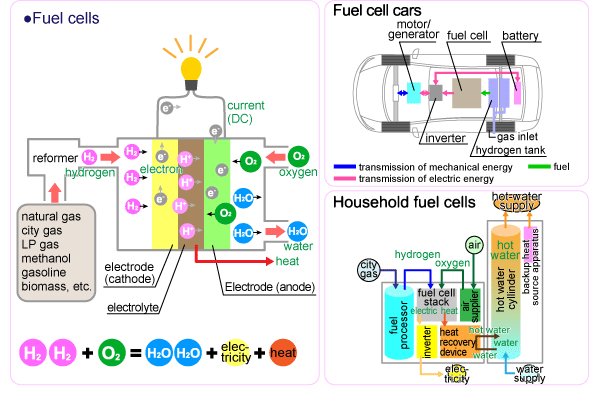The future energy technologies
Many energy technologies are under research and developmen toward commercialization or prevalence.
Particularly, technology development of power generation without CO2 emission which may cause global warming, is extremely important.
Space solar power system

The sunlight collected on the geostationary orbit in space is converted to microwaves or laser beams, then transmitted toward a collector on Earth's surface to make electricity and hydrogen for use on Earth. It is not fixed how to transmit the energy either in microwaves or laser beams, otherwise with a combination of both techniques, as their nature and function vary.
Anyway, as the sunlight is collected in space, the weather on Earth's surface or time do not affect. Research currently underway targets its commercialization in the 2030s.
Fusion power

Nuclear fusion is a phenomenon that makes two atomic nuclei collide and fuse, which occurs in the Sun. The fusion reactions bear energy, which is used for generation.
To cause fusion, nuclei collisions have to be made at high speed (1000km per second or more) and to be heated at a temperature higher than 100 million ℃ to make plasma. It is necessary to create the plasma floating in the vacuum so that the equipment could be tolerant of a temperature higher than 100 million ℃. Magnetic lines make the plasma float in the vacuum.
Nuclear fusion reactions in the plasma produce the thermal energy. A coolant flowing through the blanket removes the heat so as to generate electricity and produce tritium as a fuel. The fusion reaction stops when fuel supply is closed or automatic cooling of plasma.
Hydrogen
Hydrogen energy had attracted lots of attention in the past, and is attracting again recently.
Recent technology with high expectation is a power generation technology which utilize hydrogen as a secondary energy. In this concept, hydrogen is extracted from lignite or natural gas, then is used as a fuel to generate power. As power generation technology itself is feasible by applying conventional technology, this system is expected to be realized.


Hydrogen is colorless, odorless and the lightest gas on earth. Hydrogen is highly flammable but isolated hydrogen does not fire. It burns when mixed with air (oxygen). Ignition concentration is ranging from 4% and 75% and it burns most violently when mixed at a ratio of 1 oxygen and 2 hydrogen. Hydrogen burns to form only water, not harmful gas.
Fuel cells apply hydrogen and oxygen reactions, which is based on reverse water electrolysis.
Hydrogen is divided into electrons and ions at the cathode. Since the electrolyte is impervious to electrons, electrons flow to the anode without passing through the electrolyte to generate power. At the cathode, the electrons and the hydrogen ions combine with oxygen to make water.
Hydrogen can be produced from various raw materials such as water and fossil fuels and is expected to be used as energy in hydrogen internal combustion engine cars, fuel cell cars, and residential and commercial sectors.
However, there are many technical challenges associated with its storage, manufacture and transportation, due to the hydrogen nature which degrades and invades the material of the storage tank, so that the study to use hydrogen energy safely and easily has been continued.











